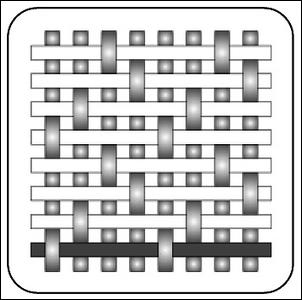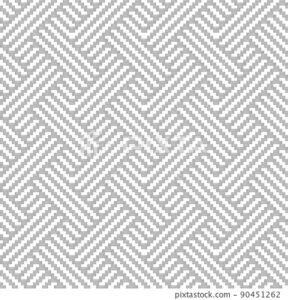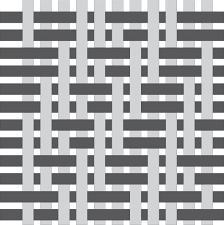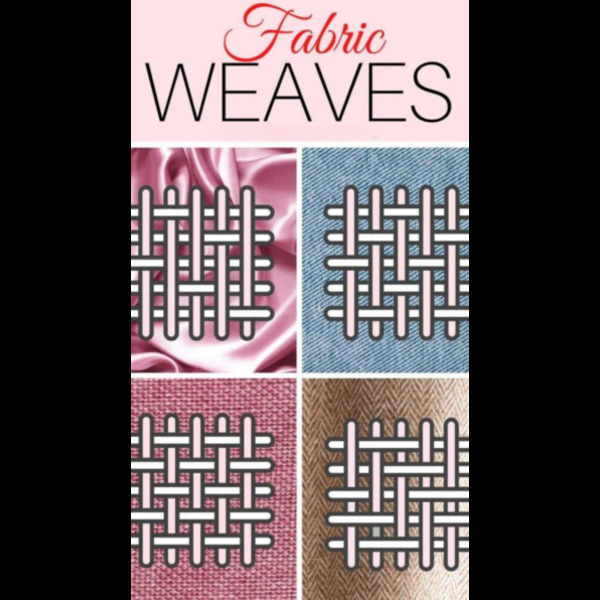- Importance of understanding different types of weaves.
- When it comes to fabrics, the WEFT & WARP plays a crucial role in determining the weave, textures, durability, and appearance of the material. Here’s a comprehensive guide to the different types of weaves commonly found in clothes by demonstrating weft and warp:
Firstly, Lets know – WHAT IS WEFT & WARP ?
In weaving, “weft” and “warp” are terms that refer to the two sets of threads or yarns that are interlaced to create a fabric. WEFT AND WARP is a foundation of fabric work.
We Gonna Relate Weft & Warp In Each Weaves, Which Will Simple & Understood able For Your Mind To Grasp.
Weft Threads (Horizontal Threads)
- Direction: Weft threads run horizontally, from one side of the fabric to the other.
- Function: Weft threads are woven in and out of the warp threads, creating the fabric. They move over and under the warp threads in a specific pattern.
Warp Threads (Vertical Threads)
- Direction: Warp threads run Vertically lengthwise, from the top to the bottom of the fabric on the loom.
- Function: They are the foundation of the fabric, providing structure and strength. Warp threads are held taut and parallel on the loom.
We, Also Provided Link Of Video Explaining Weft & Warp, By Which Reader Can Get Exactly Knowledge Of Threads To Fabrics and its Textures.
We, Hope Now You are set to know about fabrics weaves. Let’s Begin With Major Factors Of Weaves.
1. Plain Weave

- In a plain weave like poplin, tabby each weft thread goes over one warp thread, then under the next warp thread, and so on. This pattern is consistent across the entire fabric.
- Conversely, each warp thread goes over one weft thread, then under the next weft thread, and so forth.
Benefits of Plain Fabric:
- Comfort: Poplin is breathable and comfortable to wear, making it suitable for both casual and formal wear.
- Easy to Care For: It is relatively easy to care for, often being machine washable and resistant to wrinkles, especially when blended with synthetic fibers.
- Versatility: Poplin’s versatility allows it to be used in various types of clothing and home textiles.
- Description: Also known as tabby weave, poplin weave it is the simplest and most common weave.
- Characteristics: Strong and durable, it has a checkerboard-like appearance.
-
Common Uses of Plain:
- Clothing: Poplin is widely used in the fashion industry for making shirts, blouses, dresses, skirts, and pants. It is especially popular for dress shirts due to its smooth texture and crisp appearance.
-
- Uniforms: Due to its durability and ease of care, poplin is often used for uniforms and workwear.
2. Twill Weave

Twill weave is one of the three fundamental types of textile weaves, alongside plain weave and satin weave. It is characterized by its diagonal rib pattern, which is created by the way the threads are interlaced. Here’s a detailed explanation of twill weave:
-
Weaving Pattern:
- In a twill weave, the weft thread passes over one or more warp threads and then under two or more warp threads in a regular pattern. This sequence shifts by one thread in each subsequent row, creating the diagonal effect.
- A common example is the 2/1 twill, where the weft goes over two warp threads and then under one. The pattern can vary, such as 3/1 twill (over three, under one) or 2/2 twill (over two, under two).
Example of Twill Weave Pattern:
- 2/1 Twill:
- Row 1: Over 2 warp threads, under 1 warp thread.
- Row 2: Over 2 warp threads, under 1 warp thread (shifted by one thread from the row above).
- This shifting pattern continues, producing the characteristic diagonal lines.
- Description: Recognizable by its diagonal rib pattern, this weave is formed by interlacing warp and weft threads.
- Characteristics: Strong, with good drape and less wrinkling.
- Common Uses Of Twill :
-
Shirting: One of the most well-known twill fabrics, used for Shirts and other durable clothing.
-
Gabardine: A tightly woven twill fabric often used in suits and trousers.
-
Chinos: A lightweight twill fabric used for casual trousers.
-
3. Satin Weave

Satin weave is one of the fundamental textile weaves, distinct from plain and twill weaves, known for its smooth, lustrous surface and luxurious feel.
Weaving Pattern:
-
- In a satin weave, the weft (horizontal) threads float over several warp (vertical) threads before going under one warp thread. The floating threads create long, unbroken stretches on the fabric surface.
- A common satin weave pattern might involve the weft thread floating over four warp threads and then going under one (referred to as a 4/1 satin weave). The specific pattern can vary, such as 5/1, 7/1, etc.
Example of Satin Weave Pattern:
-
4/1 Satin Weave:
- Row 1: Over 4 warp threads, under 1 warp thread.
- Row 2: Over 4 warp threads, under 1 warp thread (shifted to avoid aligning with the previous row’s floats).
- Description: Creates a smooth, glossy surface with a high sheen.
- Characteristics: Luxurious feel, prone to snagging, and less durable.
-
Common Uses of Satin Weave:
-
Clothing: Satin is often used for formal wear, dresses, blouses, and lingerie due to its luxurious appearance and feel.
-
Linens: Bed sheets, pillowcases, and other home textiles may use satin weave for a smooth, comfortable texture.
-
Upholstery and Decor: Satin can be used for curtains, cushion covers, and other decorative items to add a touch of elegance.
-
6. Dobby Twill Weave

Combining dobby and twill weaving techniques results in a fabric that features the diagonal lines typical of twill, along with additional small, geometric patterns created by the dobby mechanism. This combination allows for a more textured and visually interesting fabric.
-
Complex Patterns:
- The fabric will have the characteristic diagonal ribbing of twill, enhanced with small geometric patterns. These patterns can be regular or irregular, adding a unique decorative element to the fabric.
-
Textured Surface:
- The combination of twill’s diagonal lines and dobby’s intricate patterns creates a rich, textured surface.
- Example 1: Diamond Pattern on Twill:
- The fabric shows a diagonal twill line, with small diamond shapes woven into the structure at regular intervals.
- Example 2: Dot Pattern on Twill:
- The twill weave creates diagonal lines, with small dots appearing at regular intervals along the lines.
- Description: Involves twisting warp threads around each other for an open, lace-like appearance.
- Characteristics: Airy, stable, and resistant to distortion.
Common Uses of Dobby Twill Weave
-
-
Clothing: This weave is often used in dress shirts, blouses, and other garments where a slightly more decorative texture is desired.
-
-
Home Textiles: Dobby twill weave fabrics can be used for upholstery, curtains, and other decorative home textiles.
-
-
Accessories: Scarves, ties, and other accessories may also utilize dobby twill weave for added visual interest.
Dobby Weave Catalog Link Click Here 👉
7. Calvary Twill Weave

Cavalry twill is a type of twill weave known for its distinctive, pronounced diagonal ridges and its durability. It is often used in military uniforms, hence the name “cavalry.”
-
Pronounced Diagonal Ridges:
- The twill lines in cavalry twill are more pronounced and wider than those in standard twill weaves. This creates a strong, visible diagonal pattern on the fabric surface.
-
Durability:
- Cavalry twill is made to be durable and hard-wearing, making it suitable for uniforms and heavy-duty garments.
-
Structure:
- It typically has a steep twill angle, often achieved by using a 2/1 or 3/1 twill pattern, where the weft threads pass over two or three warp threads before going under one. The specific arrangement can vary but is designed to enhance the fabric’s strength and texture.
-
Texture and Appearance:
- The fabric has a robust, textured feel with well-defined diagonal lines. It often has a matte finish, though it can also have a slight sheen depending on the fibers used.
Example of Cavalry Twill Weave Pattern
- 3/1 Cavalry Twill:
-
In a 3/1 twill pattern, the weft thread goes over three warp threads and then under one warp thread. This pattern shifts by one warp thread in each subsequent row, creating the characteristic diagonal lines.
-
Row 1: Weft thread goes over three warp threads, then under one warp thread.
-
Row 2: The pattern shifts by one warp thread, so the weft thread starts by going under one warp thread, then over three warp threads, and so on.
-
Diagonal Lines: This shift creates strong diagonal lines running across the fabric, which are the hallmark of cavalry twill.
Common Uses of Cavalry Twill
-
Military and Police Uniforms: Due to its durability and sharp appearance, cavalry twill is often used in uniforms.
-
Trousers: It is a popular choice for high-quality, durable trousers.
-
Outerwear: Jackets, coats, and other outerwear items benefit from its sturdy structure and appealing texture.
-
Description: Created using a special loom, it produces intricate, textured patterns.
-
Characteristics: Complex designs, rich texture, and durable.
Calvary Twill Weave Catalog Link Click Here 👉
Understanding these various weaves can help you make informed decisions when selecting fabrics for your projects. Each weave type offers unique qualities, making them suitable for different applications and styles. Whether you’re looking for something durable for everyday wear or something luxurious for special occasions, there’s a weave type that fits your needs perfectly.
Thank You 😊





